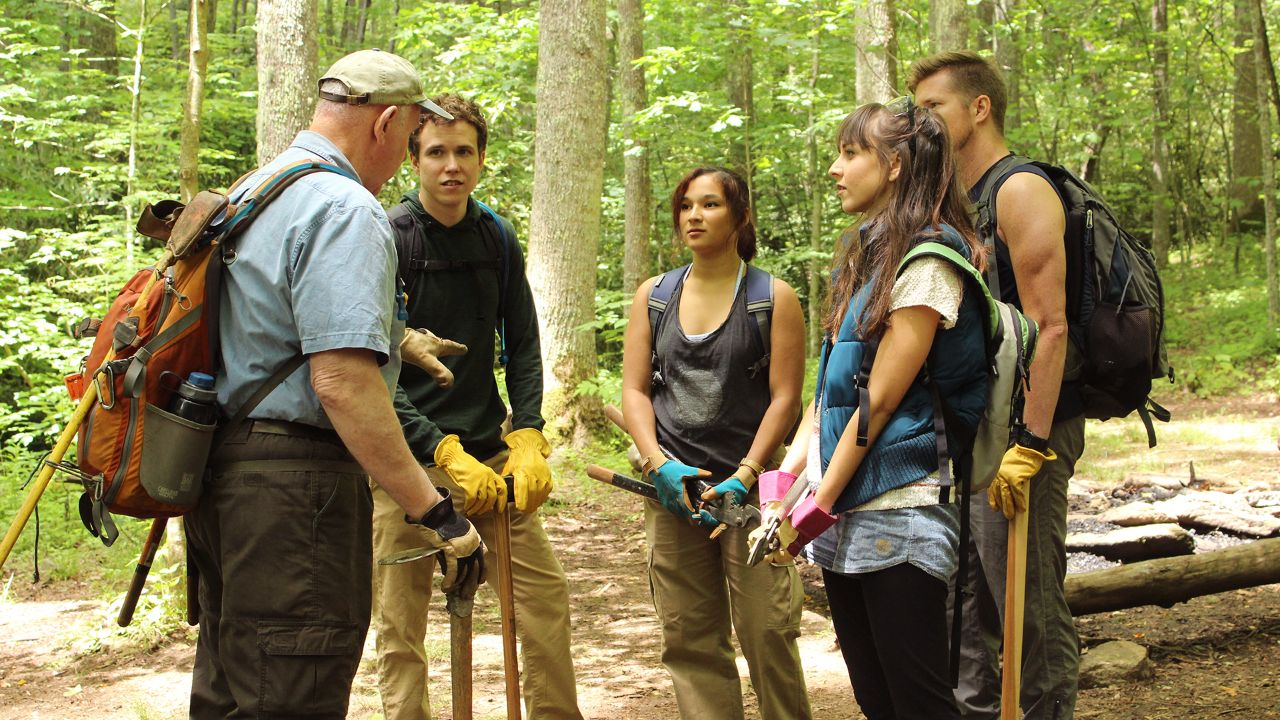Appalachian Trail Guides

Above photo: Skip Sheldon teaches volunteers to control water drainage, install steps and remove fallen trees. Photo by Emanuel Vinkler
Story by Jesse Hirsch
Jesse lives in Brooklyn, where he writes about food, agriculture and travel.
Trail veterans share their experiences.
Stretching from the wilds of Maine all the way down to sunny Georgia, the Appalachian Trail brims with magic and lore. Countless hikers hop on and off portions of the trail, content to spend a day or a week taking in a bit of its majesty. But for “thru-hikers,” those hardy souls who make it their mission to trek the entire 2,200 miles from end to end, a deeper knowledge is required. That’s where trail guides come in.
Thousands of volunteers pitch in each year, to keep the trail shored up and clear of debris, to ensure wildlife habitats along the trail can thrive, and to help thru-hikers achieve their dreams of making it all the way. Their assistance can come in the way of a friendly bit of encouragement. Sometimes, it involves a replenishing of snacks and other supplies. But it also comes in the form of sharing wisdom, which the volunteer trail guides have in spades.
In North Carolina, we caught up with a couple of the Appalachian Trail’s savviest volunteers to reap the benefits of their collective knowledge. They’ve seen their share of experiences on the trail, both the highs of peak achievement and the inevitable hardships. Luckily, these guys were as generous with their time as they would be for any thru-hiker; we were lucky to pick their brains.
Skip Sheldon
Skip Sheldon is a fly fisherman, a grouse hunter, a father of two grown sons, and a retiree in his mid-70s. He also has an abundance of character and is one of the Appalachian Trail’s most dedicated volunteers. One thing he isn’t? A thru-hiker.
No need for glory
“I was going to [hike the whole trail], then I retired and got into trail maintenance. I realized that going home to a hot meal and shower at the end of the day isn't all that bad. Now, I don't think I'm ever gonna thru-hike it. Ain't gonna happen.”
The “flip flop”
“When you’ve got 6- or 7,000 hikers going in the same direction at around the same time, that overstresses the trails, the facilities — the whole woods. What they're encouraging now is, you should start at Harpers Ferry, the theoretical midpoint of the trail, and hike down to Georgia. Then you would turn around and head to Maine and hike back down to Harpers Ferry. Or vice versa, or whatever variation you can think of. That's called a flip flop. If people do different sections at different times, it helps relieve the trails.”
Three types of hikers
“I’m going to generalize here, but there are three general groups hiking the AT. There’s the young folks, where it’s basically a six-month moving party. They hike together, go to town together, get drunk together, sing and so forth. There’s been an ungodly number of marriages from kids meeting on the trail.
The second group, say 30 years old to their late 50s, something has happened in their life. Could be divorce, death of a child, loss of a job, health issue — something happened to throw them for a loop. They need time to get their head straight, get their life back on track. Lot of those folks on the trail.
The third group is the old retired people. They've wanted to do it their whole life but couldn't because of kids, jobs, what have you. Those are frequently couples in their 60s or 70s, having a ball. Lot of ‘em don't make it all the way because they're in no particular hurry. We met one gal on our section in July; she was 80-something, just lovin’ it.”
Wear and tear
“It's hard on the body! You're carrying a 25- or 30-pound pack, hiking all those miles each day, just pounding those joints. You slip on a branch, twist your ankle — it's tearing your body up. And lots of the thru-hikers are trying to make good time. You can't sit out a rainstorm if you're gonna make it to Maine, but it takes a toll.”
Bill Sanderson
Bill Sanderson taught high school biology in Asheville, North Carolina, for three decades. He also ran a summer wilderness program for a local conference center for 25 summers. When he retired from both gigs several years back, Bill realized he missed engaging with nature on a regular basis. Now, he’s a member of the Carolina Mountain Club, helping maintain a long swath of the Appalachian Trail and assisting countless hikers along their journeys.
Labor of Love
“Whenever I go out on a hike, I always hike with an ax, sometimes a hazel hoe. I’m the type of guy who can’t hike anywhere without seeing trail issues that need to be fixed. I don’t care whose trail I’m on; I’ll fix it! That’s why I threw in with the Carolina Mountain Club.”
Always working
“The mountain club has seven crews that go out on the trails every week: Monday crew, Tuesday crew, Wednesday crew, Thursday crew, Friday crew and two weekend crews. And that’s every week! Each crew has 15 to 25 people, every day; it’s a huge effort to keep the trails up to speed and free of obstacles.”
Unlikely heroes
“When you're doing maintenance you're a hero. You walk out on the AT with a hazel hoe, and every hiker knows that you're a maintainer. We always carry a big bag filled with candy bars on our waistband. Every time I meet a thru-hiker, I offer them one: ‘Sure!’, they say. I've never seen a thru-hiker turn down a candy bar. You get to be their hero for a moment, brighten their day and send them on their way. What's not to love about that?”
“Trail magic”
(Note: Trail magic is generally defined as an unexpected act of kindness on the Appalachian Trail).
“Some people are very serious about trail magic. They’ll set up tables, cook meals, have snacks, Band-Aids, batteries — things the hikers need. I love to give away double and triple A batteries. I’ll say to them, ‘How's your headlamp?’ Makes their day. There's a guy in Pennsylvania, and he's famous. He carves little wooden spoons, paints the handles different colors, then puts a little AT symbol on the handle. Then, he puts the spoons in Ziploc bags along the trail near his home. It's a really interesting culture.”
Sense of purpose
“No matter why you start [hiking the trail], you develop some sense of purpose along the way, some deeper goal. Hikers often say that they're surprised by this. It’s like they didn't know why they started but now they know. And that’s true even if they don't finish. Those who don’t finish, most will come back and try it again. They just can't live with themselves until they do it."
Nature’s glory
“As a biologist, I spent my career trying to convince people the outdoors is a special place, and I continue to do that now. You need to understand nature to appreciate it. You'll protect what you love, and you'll love what you understand.”
Portions of these interviews have been edited and condensed for clarity.
Preserving the Appalachian Trail
A group of friends heads into the forest to help restore the 2,200-mile-long Appalachian Trail.
Best Section Hikes on the Appalachian Trail
Find out which part of the Appalachian Trail is calling your name.

Start A Reservation
Enjoy fast and easy car rental bookings from Enterprise Rent-A-Car at one of our 7,200 branches in cities, airports and neighborhoods near you.
Reserve Now
Email Offers
Don't miss an excuse to hit the road: our latest offers delivered to your inbox.
Sign Up

